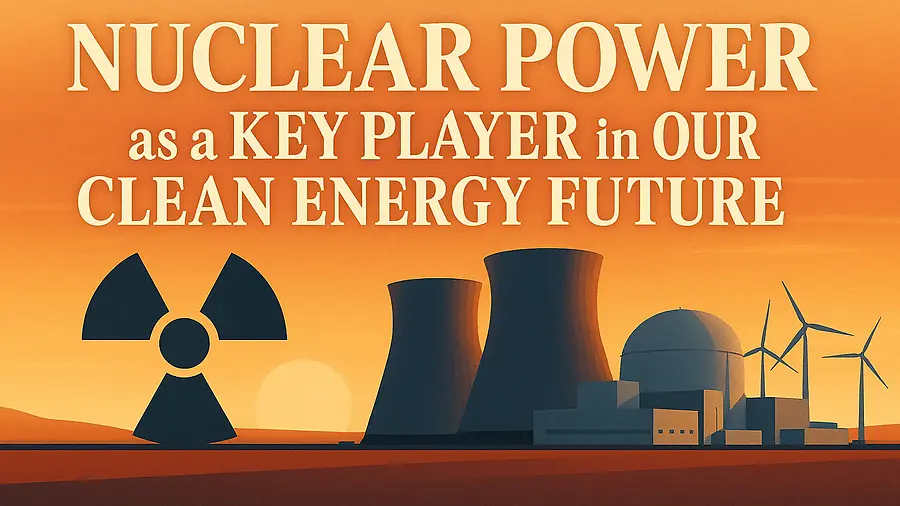Nuclear Power
A Key Player in Our Clean Energy Future

The world stands at a dangerous crossroads. As global electricity demand surges toward 15,000 gigawatts by 2050 — a staggering 70% increase from today — the pressure to decarbonize is intensifying by the hour. Artificial intelligence alone will drive a seismic shift in energy use: by 2030, AI infrastructure will require 160% more electricity, consuming the equivalent output of the entire nation of Canada. Meanwhile, climate scientists warn that to avoid catastrophic consequences, we must keep global warming below 1.5°C — a threshold the world is already approaching with alarming speed.
In this pivotal moment, nuclear power is no longer a fringe option or a last resort. It is emerging — clearly and unequivocally — as an indispensable cornerstone of any realistic clean-energy transition.
The Carbon-Free Powerhouse the World Has Overlooked
Nuclear energy remains one of the safest, cleanest, and most climate-friendly electricity sources on Earth:
- 6–17 grams of CO₂/kWh across its lifecycle
- Comparable to wind
- Lower than solar (21–42 grams CO₂/kWh)
- Orders of magnitude cleaner than coal (1,000 grams) and natural gas (500 grams)
Few people appreciate the scale of nuclear energy’s climate impact. Over the past 50 years, nuclear plants worldwide have prevented more than 70 gigatons of CO₂ emissions. Today, the global nuclear fleet avoids 2.1 billion tons of CO₂ every year — the equivalent of removing one-third of all cars on Earth or nearly twice the annual carbon footprint of global aviation.
France stands as the strongest proof that nuclear power can be deployed both quickly and effectively. In just 15 years, the country transitioned to a system where more than 70% of its electricity comes from nuclear energy — cutting electricity-sector emissions to one-sixth of the European average.
When the world needs clean energy fast, nuclear delivers.
Reliability in an Intermittent World
Wind and solar are essential to a clean future — but by their nature, they are intermittent.
- Solar produces nothing at night.
- Wind can drop to zero without warning.
- Both require massive energy storage the world does not yet possess.
Nuclear power, by contrast, provides 24/7 reliability.
In 2024:
- Nuclear plants achieved an 83% capacity factor, generating maximum power 92% of the year.
- Nuclear outperformed every other energy source — twice as reliable as gas or coal, and almost three times more reliable than wind or solar.
Grid reliability is no longer optional; it is a matter of national and technological survival. The April 2025 blackout on the Iberian Peninsula made this painfully clear. When 15 gigawatts suddenly fell off the system — roughly 60% of Spain’s grid — millions lost power within seconds. At the time, 70% of electricity was sourced from wind and solar, leaving the grid without the stabilizing “shock absorbers” provided by the spinning turbines of nuclear and thermal power plants.
As climate change accelerates extreme weather — and as AI pushes demand vertically upward — nuclear power’s steadiness becomes the backbone of a functioning society.
The Advanced Nuclear Revolution
We are living through a renaissance in nuclear technology.
Small Modular Reactors (SMRs)
SMRs (up to 300 MWe) are compact, factory-built, and designed for rapid deployment. More than 80 designs are in development worldwide, with 68 already moving toward commercialization.
Key advantages:
- Lower upfront costs
- Standardized designs
- Faster construction
- Smaller footprints
- Ability to be sited at retiring coal plants
- Incremental power additions
Some SMRs are small enough to transport by truck. Others can be installed underground in reinforced structures engineered to withstand earthquakes, flooding, cyberattacks, and even aircraft impact.
Revolutionary Safety Features
NuScale’s SMR design uses fully passive safety systems — no pumps, no AC/DC power, no operator intervention. These reactors automatically shut down and self-cool indefinitely.
This breakthrough allowed regulators to reduce the traditional 10-mile Emergency Planning Zone to the plant boundary.
Generation IV Advanced Reactors
Generation IV designs push the frontier further:
- 100–300x energy extraction from the same fuel
- Waste that remains hazardous for centuries, not millennia
- Operation at ambient pressure
- Fully passive shutdown mechanisms
China operates the world’s first commercial Gen IV reactor (HTR-PM). The U.S. is close behind with developments such as Kairos Power’s Hermes molten salt reactor and a wave of advanced technologies preparing for deployment.
Economic Engines for Communities
A nuclear plant is not just an energy asset — it is a regional economic anchor:
- $470 million in annual local goods and services
- $40 million in local labor income
- Every $1 spent generates $1.87 nationally
- 68,000+ nuclear workers in 2023, with salaries 50% higher than other energy sectors
- Every 100 nuclear jobs support 250 additional jobs
Construction of a large reactor can employ up to 9,000 workers. Replacing retiring coal plants with SMRs could add 650+ new jobs per region, revitalizing communities while reusing existing infrastructure and skilled labor.
The Global Race to Build Nuclear Capacity
The International Atomic Energy Agency (IAEA) has raised its nuclear projections five years in a row — an extremely rare upward revision.
By 2050:
- High case: global capacity rises from 377 GW to 992 GW
- Low case: a significant increase to 561 GW
Momentum is undeniable:
- 417 reactors operating as of 2024
- 70 under construction
- 56 new reactors built in the past decade, primarily in Asia
- China expected to surpass U.S. and EU nuclear capacity by 2030
At COP28, more than 20 countries committed to tripling global nuclear capacity by 2050.
The United States alone will need 200 GW of new nuclear capacity to reach net-zero emissions by mid-century.
Why Big Tech Is Betting Big on Nuclear
AI and cloud infrastructure are becoming so energy-intensive that tech giants are turning to nuclear power:
- Microsoft: 20-year agreement to restart Three Mile Island Unit 1, supported by a $1.6 billion investment
- Google: Partnership with Kairos Power to develop up to seven SMRs
- Amazon Web Services:
- $650M nuclear-adjacent data center
- SMR partnerships with Dominion Energy and X-Energy
- $500M investment in X-Energy through the Climate Pledge Fund
Goldman Sachs estimates that 85–90 GW of new nuclear power is needed to meet projected data center demand by 2030.
For Big Tech, nuclear is not a “green initiative” — it is a necessity.
Public Support Has Turned a Corner
Public opinion has shifted dramatically. According to the 2025 National Nuclear Energy Survey:
- 72% of Americans support nuclear energy
- Supporters outnumber opponents 3 to 1
- Strong supporters outnumber strong opponents 5 to 1
- 83% believe nuclear will be important to America’s future
- Even climate skeptics show the highest net support for nuclear among all clean technologies
Nuclear energy’s most overlooked strength may be this: it unites people across political and ideological divides.
Safety and Waste: The Facts, Not the Fears
Across more than 18,500 reactor-years of operation in 36 countries, the world has experienced only three major accidents — each of which fundamentally improved global safety standards.
Today’s reactors:
- Experience almost no significant safety events
- Keep worker exposures far below regulatory limits
- Use robust passive safety systems
- Are built to withstand extreme natural events
On nuclear waste:
- All U.S. spent fuel ever produced could fit on one football field, 10 yards high
- Modern dry casks withstand earthquakes, floods, and aircraft impact
- Finland, Sweden, and France are leading with deep geological repositories
- The U.S. has operated the Waste Isolation Pilot Plant safely since 1999
- In 2025, Oklo launched the first private commercial fuel-recycling facility
Nuclear waste is managed safely. Fossil fuel waste is not.
Nuclear + Renewables: The Partnership We Need
Wind, solar, and nuclear are not competitors — they are complements.
- Renewables are fast and cost-effective.
- Nuclear provides stability and reliability.
- Advanced reactors can “load follow,” adjusting output to support variable renewable generation.
France has demonstrated this model at scale for decades.
The IEA Net Zero scenario calls for:
- Tripling nuclear capacity
- Massive renewable expansion
- A balanced, resilient clean-energy mix
This is not an “either-or” transition.
It is an all-of-the-above clean energy strategy.
The Path Forward
Nuclear energy stands at a global inflection point. For the first time in decades, technology, economics, public sentiment, and climate reality are aligned.
The question is no longer whether nuclear belongs in our clean energy future.
The real question is:
How fast can we scale it?
The nuclear generation record set in 2024 is not a victory lap — it is a rallying cry.
With bold leadership, forward-thinking policy, and sustained innovation, we can triple global nuclear capacity by 2050 and steer humanity toward a cleaner, safer, more sustainable future.
Nuclear power is not just a key player — it is the linchpin in the fight against climate change.
We owe future generations a livable planet. Nuclear power gives us a fighting chance.
Now is the time to act.


